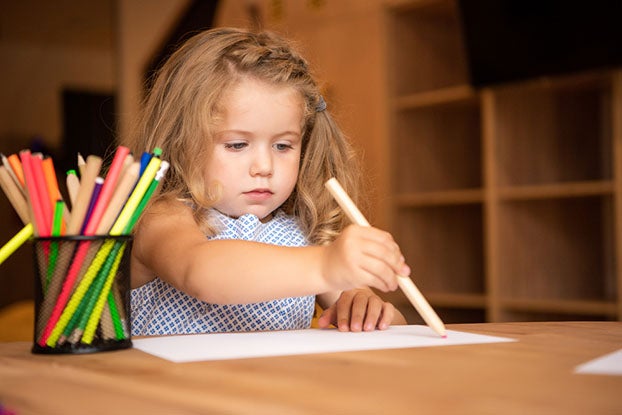And the skill is…. Storytelling!
We’re diving into storytelling! Storytelling helps kids understand and process information. It improves their imagination and communication skills. Being able to tell a story also helps build kids’ social-emotional skills. As they create characters and put them in new situations, they’ll practice looking at situations from different perspectives.
Below are some tips for implementing storytelling skills into your child’s learning routine!
Focused Learning Time (15 – 30 minutes)
Ages 2-3: Choose your favorite HOMER story, or try out a brand new one! You can read it out loud, or use the “Read to Me” function.
Ages 3-4: Create a scene using HOMER’s Make Your Own Story templates. When you’re finished, take a screenshot (or even print it out if you can) and have your narrator practice telling their brand new story. Later on, you can share the story with their beautiful illustrations!
Ages 5+: Create a Story Mashup! Get 3 cups and rip up 9 small pieces of paper. Ask your child to give you 3 characters, 3 places, and 3 emotions. Fold the papers, and then put each “category” in its own cup. Have your child pick out one piece of paper from each cup, and read out which character, place, and emotion they selected. Then, challenge them to make up a story using all 3! They can use Homer’s “Let’s Draw” board or their own paper and art materials.
Whole Body Movements (5 – 15 minutes)
Age 2-5+: Create an obstacle course with a fun, engaging story to excite kids about working out. We really like this Peppa Pig story! For kids between the ages of 2-3, the course could be much shorter and easier. For example, you could have them crawling under or over things and doing movements in place. You could also replace the “story” that can be acted out like “Old Macdonald” or “We’re going on a bear hunt”. (For the bear hunt it could be cute to put a teddy bear somewhere at the end of the course so they can find the bear!)
Fine Motor Activity (10 – 20 minutes)
Age 2-3: Do a hands-on pasting version of HOMER’s Make Your Own Story activity. Cut out pictures of characters, settings, and objects, making sure to choose your child’s favorites. They can then paste these cutouts onto paper or cardboard, making up a story as they go. You can even add a short 1-3 sentence written story at the bottom.
Age 3-4: Do a cut and paste version of HOMER’s “What comes next?” lesson. Draw 3 or 4 scenes. Then have your child cut out and put the scenes in the order they think is best. Once they’re done, challenge them to tell you the story. Even if the order is different than what you’d expect, praise the new, surprising narrative they come up with. If you want to make this activity work for multiple kids, you have one child can draw the scenes, and the other can create a story sequence.
Age 5+: Create a flipbook! Show your child how drawing the same image with small changes can create an illusion to make an image look like it’s moving. Then get them to try it themselves! If you need inspiration, check out this how-to post!
Yoga or Stretching (10 – 20 minutes)
Ages 2-3: Make up a story with characters who have opposite sizes, like a big, humongous giant and a teeny tiny fairy, or act out an existing story. You can act out big and small, long and short, wide and narrow to get your child’s body warmed up.
Ages 3-5+: It’s Springtime! Pretend to be a flower. Start as a tiny seed by doing child’s pose, then grow your stalk by moving from downward dog to mountain pose, and finally, bloom! You can do this by extending your arms and bringing them down by your side.
Free Play (15 – 60 minutes)
Age 2-3, 3-4, and 5+: Get dramatic! Put on a showing with finger puppets or play dress up!
Reading/Story Time (15 – 30 minutes)
Ages 2-3: Read a story with pictures, rhymes, and/or repetitive text so your child can be part of the storytelling! Then, let your child pick their favorite toys or stuffed animals and make up a brand new story with them.
Ages 3-5+: Start making some fan fiction! Get your child to choose their favorite character, toy, or stuffed animal and make up a story about their adventures. Your child can be the author and illustrator and once they’re done, they can tell it to the entire family!
Family Helping Time (10 – 20 minutes)
Age 2-3: Read a story or watch a video about a daily routine or chore with which your child may struggle sometimes, for example, you could choose, How do Dinosaurs Say Goodnight? if your child has a hard time with bedtime. Challenge them to be like the character in the story.
Age 3-5: Read your favorite story about a character that was helpful, and talk with your child about the ways they can help you around the home. Then challenge to “Be like” that character during daily routines.
Making Memories (20 – 30 minutes)
Ages 2-4: A story doesn’t have to be in sequence! Throughout the day, have your child collect keepsakes from their experiences. At the end of the day, you can work together to create a collage, time capsule, or other display of everything they’ve collected. These items can be simple! For example, they could collect a cheerio from breakfast, a flower from the backyard, and a drawing from art time. Whatever they come up with, arrange it on a piece of cardboard or in a shadowbox to capture the day.
Ages 5+: Talk about your day and the memories you made together — encourage your child to think of individual moments, rather than recapping the whole day. Ask them to pick their favorite moment and draw a picture of it. You can write down their memory as they draw, giving you both a little piece of the day to look back on!
Snuggle Time (15 – 30 minutes)
Ages 2-4: Read a bedtime story with wonderful pictures and repetitive text. Let your little one follow along and eventually chime in as they read it with you again and again!
Ages 5+: Take turns making up a brand new story. Start with, “Once upon a time there was a…” and let them fill in the blanks. Make it silly — anything goes! See if you can make the zaniest story ever!
Caregiver Gets Some Work Done Time! (30-60 Minutes)
Ages 2-5+: Explore stories in Homer Reading in the practice section using the Read to Me function or invite a family member to read or tell them a story virtually!













